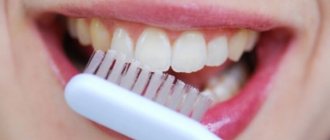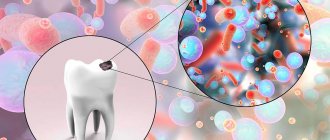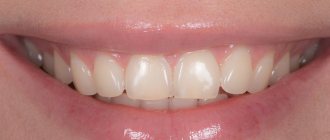One of the most popular and quite effective ways to whiten teeth at home is whitening with hydrogen peroxide. It is worth noting that this substance is also used by dentists for whitening in a stationary dental clinic. True, there it is not used in its pure form, but in combination with various components that reduce the destructive effect of peroxide on tooth enamel. For example, with remineralizing gels that contain glycerin. Many people also whiten their teeth with healing tea tree oils.
Therefore, when using peroxide yourself at home, you need to be careful.
Is it possible to whiten teeth with hydrogen peroxide?
With age, every person's tooth enamel becomes thinner and becomes covered with roughness that is invisible to the naked eye.
As a result of smoking, regular consumption of food containing dyes, as well as drinking coffee and tea, a kind of pigmented film is formed on the surface of the teeth, tightly attached to the rough surface of the teeth. It is impossible to remove it with even the most expensive paste, so to restore a beautiful smile, it is necessary to periodically carry out the whitening procedure. In order not to harm the enamel, it is better to entrust such a procedure to specialists. However, if this is not possible, you can resort to gentle remedies at home.
When the need arises to whiten teeth at home, many people use hydrogen peroxide. This product really works as an effective bleach and can eliminate yellow plaque, age spots and darkening.
Dentist on the advantages and disadvantages of teeth whitening with peroxide:
Operating principle
Penetrating into the enamel and dentin of the tooth, the drug reacts with dental tissues, releasing oxygen, which causes organic substances to break down into simpler compounds. Thus, oxygen helps remove plaque.
Sometimes peroxide is used as an antiseptic - for colds, it is used to gargle. For such rinses, a weakly concentrated solution is used, which does not affect the enamel, but also does not have a whitening effect.
What do they say about this method?
Many people use this method to achieve whiter teeth at home. Most of them who adhere to the recommendations get the desired effect.
If you are familiar with the methods described, you can provide feedback by adding a comment to this article.
Well, what do dentists say about home enamel whitening techniques? Let’s watch the following video:
If you find an error, please select a piece of text and press Ctrl+Enter.
Tags teeth whitening hydrogen peroxide
Did you like the article? stay tuned
Previous article
Oral sanitation: what is it, how is it done, cost
Next article
Tea tree oil for home teeth whitening
Indications for use
The whitening procedure is indicated in the following cases:
- Yellowing of the enamel due to heavy smoking, drinking large amounts of coffee and tea.
- Regular use of medications containing fluoride. Such preparations include toothpastes and preventive gels with a high content of this microelement. They can only be used periodically, as prophylactic agents.
- Long-term use of tetracycline group medications.
- Yellowing of the enamel color as a result of natural aging of the body.
Preparing your teeth
Since the whitening procedure is quite harmful to tooth enamel, before starting it, measures should be taken to minimize the likelihood of negative consequences.
First of all, visit a dentist who will determine the condition of your teeth and enamel. Any manipulations using peroxide can only be carried out by those people who have thick and fairly durable enamel.
The dentist will examine the teeth, identify areas with darkening and yellowing and determine the nature of their origin. If the yellowness is not outside, but inside the tooth, then peroxide will not give the expected whitening result.
Whitening at home
There are quite a few different ways to lighten teeth with peroxide, and they all have a good effect.
Important! Only 3% peroxide is allowed to be used, since more concentrated solutions will inevitably lead to damage to the enamel.
Peroxide rinse
Rinsing with pure peroxide is one of the simplest methods, so it is recommended for people who are limited in time.
Thus, the rinsing procedure takes no more than 5-10 seconds, which is very convenient if you are in a hurry to work in the morning and do not have the opportunity to spend time preparing the compositions. You should not keep the product in your mouth for more than 10 seconds - this will help minimize the risk of damage to the enamel. During the procedure, tingling and some burning may occur - this is absolutely normal, so there is no need to worry. After rinsing, you need to moisten a cotton swab in the preparation and gently wipe the problem areas.
Then rinse your mouth with warm water and refrain from eating or drinking anything for at least 30 minutes.
For prevention purposes, this method is recommended to be used once a week. If you need to lighten your teeth and remove pigment plaque, rinse your mouth once a day. As a rule, this procedure works quickly and the effect becomes noticeable after 2-3 weeks.
Brushing with a toothbrush
This method also does not take much time and effort.
Whitening is carried out in three stages:
- First, brush your teeth with a toothpaste that contains fluoride.
- Then mix warm water and peroxide in equal proportions in a glass and, dipping the brush into the glass, brush your teeth for 1 minute.
- Rinse your mouth and refrain from eating or drinking anything for the next 30 minutes after the procedure.
Soda mixture
Baking soda is an excellent bleaching agent.
There are recipes for teeth whitening using only soda. When used in combination with peroxide, you will get maximum benefit and visible results. The process itself is performed as follows:
- First of all, prepare a thick paste from peroxide and soda.
- Then apply it to the surface of your teeth. You can use a cotton swab or your fingers to do this.
- Leave the mixture on your teeth for 3 minutes, then rinse your mouth with warm water.
- Afterwards, brush your teeth using fluoride toothpaste.
When using soda and peroxide, it is important to adhere to the following rules :
- Do not use a toothbrush, especially one with hard bristles, to apply the mixture.
- Avoid contact of the mixture with mucous membranes and gums.
- Do not allow the mixture to come into contact with your teeth for more than 3 minutes.
A blogger tries to whiten teeth using a similar recipe:
With water
The whitening process consists of three stages:
- Brushing teeth using fluoride toothpaste. It has a protective effect on the enamel and prevents it from damage.
- Next, you will need to prepare a rinse. For this purpose, mix peroxide with boiled water in equal proportions. Rinse duration is one minute.
- Finally, rinse your mouth with plain water, which will wash away any remaining medication. It is not recommended to consume food or drinks for 30 minutes after the procedure.
With pasta
In a small container, mix peroxide and toothpaste in equal proportions and use the resulting mixture in the morning to brush your teeth.
Soda and salt solution
To properly prepare the solution, you will need :
- 1 part peroxide.
- 2 parts water.
- A pinch of salt.
- A pinch of soda.
Rinse your mouth with the resulting solution for 1 minute.
With tooth powder
Dip the brush in tooth powder and gently apply 2-3 drops of peroxide on top. After this, you need to brush your teeth as usual and rinse your mouth with water.
Soda, hydrogen peroxide, lemon
Prepare a paste of 2-3 drops of lemon juice, peroxide and soda. Apply the mixture to a soft toothbrush and gently brush your teeth.
Video on the topic:
Individual cases
Some fabrics require special treatment, while others can easily withstand high temperatures and aggressive detergents.
Linen, cotton
Bleaching cotton and linen items using hydrogen peroxide in an automatic washing machine. To do this, add 10–15 ml of peroxide to the cell with the washing composition. Washing time – 5–7 minutes. The water temperature should be 60–70 °C.
Cotton can also be bleached in the washing machine.
Synthetics
Synthetic fabric interacts well with the acid contained in lemon juice:
- Fill a basin with heated water.
- Squeeze the juice from half a lemon and add 1–1.5 teaspoons of hydrogen solution.
- Soak the clothes for up to half an hour, remove and rinse.
For this bleaching method, the water must be warm.
Make sure that things are completely immersed in liquid when soaking, otherwise there is a high probability of color discrepancy after the procedure.
Delicate fabrics and underwear
Thin underwear and clothes made from delicate types of fabric require special care and treatment. Whiten underwear with peroxide manually.
For this:
- Fill a small bowl with water at room temperature.
- Dissolve 3 tbsp in it. spoons of 3% hydrogen solution.
- Place the laundry in a basin and leave to act for about an hour.
- After the allotted time has passed, take out bras, T-shirts and panties, rinse and send to dry.
Drying white underwear
To bleach delicate fabrics, a solution with the following composition is also used:
- 5 liters of water;
- 1 tbsp. spoon of powder;
- 4 tbsp. spoons of salt;
- 1 tbsp. spoon of peroxide;
- 1 tbsp. spoon of ammonia.
Make sure all components are dissolved, soak the laundry for about 2 hours. Rinse and dry.
Advice! Use only granular powders and liquid gels designed for treating white laundry.
Wool and silk
Items made of wool and silk, as well as items containing this type of fiber, should be bleached by hand washing.
Prepare a solution from the following ingredients:
- 10 liters of water heated to 30–35°C;
- 200–220 g kitchen salt;
- 25–30 g washing powder;
- 600–800 ml of hydrogen peroxide.
If the fabric has an unpleasant odor, wash it with a small amount of powder
Soak silk or woolen items in the prepared liquid for up to 5 hours. After the allotted period of time has passed, take out the clothes, rinse them in a bowl of water at the same temperature, and dry them in a horizontal position.
Peroxide based gels
Today on sale you can find special gels containing hydrogen peroxide and a special substance - urea, which, due to its properties, promotes the active production of oxygen when in contact with air.
Among the most common whitening gels are:
- White Perfect - this product is often used by professional dentists, which confirms that it meets all safety requirements.
- Brilliant is a gentle product, suitable for those with sensitive enamel.
- Teeth Whitening Pen - the product is available in the form of a pencil with a brush, which greatly facilitates the application process.
- White Light is a gel designed for use with mouth guards and a UV lamp. Those who decide to use this particular drug will have to take care of purchasing a lamp and cap.
Precautionary measures
- Before using peroxide, you need to do a sensitivity test by applying the product to the inside of the elbow.
- Peroxide is a very strong oxidizing agent. It can not only lighten teeth, but also increase their sensitivity. Therefore, people who experience discomfort or painful sensations on their teeth while eating hot or very cold food should avoid using this product.
- Also, people with periodontal disease, caries and teething wisdom teeth should not use this product.
- Peroxide should not be used by children under 12 years of age, since their tooth enamel is still developing and is not very dense. Pregnant women and people who wear braces or crowns should avoid using peroxide as a teeth whitener.
Reference! You can use peroxide for teeth whitening no more often than 1 course, consisting of 2-3 weeks, every 2-3 months.
How often can the procedure be repeated?
You can use hydrogen peroxide at home for no more than 14 days. Further, constant exposure of the substance to the enamel can lead to a deterioration in its condition, gradual thinning and the development of hyperesthesia. One procedure per day will be quite enough. During the course, some experts advise using fluoride-containing paste to eliminate the risk of tissue demineralization. As with peroxide, it is best to consult your dentist about using products containing high fluoride content.
Effect of use
The effect of lightening the color of teeth by 1-2 shades will occur already 2-3 weeks after the start of the procedures. To prevent repeated darkening of the enamel, it is advisable to repeat the procedure at least 2-3 times a year.
Possible negative consequences
When using peroxide, you need to be careful not to harm your dental health. Thus, an incorrectly performed procedure can cause bleeding gums as a result of a chemical burn.
If you have a filling, you should take into account that if it does not fit tightly, peroxide can penetrate inside the tooth, which will lead to accelerated destruction.
Experiment using peroxide for whitening:
Method for removing yellow stains from white shirts
Very often, owners of white blouses and shirts are faced with the appearance of yellow stains from sweat and marks left by deodorants. Such pollution is striking and looks unaesthetic and repulsive. Fresh stains on white shirts can be removed by washing with regular detergent. But with things that have been lying around for several days, the situation is different.
You need to prepare a bleaching solution:
- heat 4 liters of water to 60–70°C.
- add 2 tbsp. spoons of all-purpose soda ash;
- dilute 2 teaspoons of hydrogen peroxide.
All-purpose soda ash will help whiten a white shirt.
Dip the shirt into the solution for a quarter of an hour, rinse, and dry on hangers.
The juice of 1/2 lemon and a teaspoon of peroxide will help remove yellowness on a synthetic blouse. Use a sponge soaked in this solution to go over the areas of contamination. Or wash the necessary areas with the resulting composition.
If you don’t like the proposed methods, then pay attention to an effective bleach from Aliexpress.
Advantages and disadvantages
The method has both advantages and some disadvantages. Benefits include :
- Availability.
- Efficiency.
Among the disadvantages are:
- The presence of a large number of contraindications.
- High probability of enamel injury.
Contraindications
The use of this drug is contraindicated in the following cases :
- Diseases of the oral cavity occurring in the acute stage.
- Caries, periodontal disease.
- Presence of braces or other orthodontic systems.
- Weak enamel.
- Age up to 12 years.
In the absence of the listed contraindications, it is still advisable to consult a dentist and carry out the procedure only with his consent.
Contraindications
It is imperative to take into account that there are certain contraindications to the use of hydrogen peroxide:
- pregnancy;
- breastfeeding period;
- development of periodontal disease;
- gum disease;
- increased sensitivity of enamel;
- extensive carious process;
- the presence of a large number of fillings;
- installed braces;
- allergy to peroxide;
- childhood and adolescence.
If any of the above factors are present, it is necessary to select other teeth whitening methods.
Reviews from doctors and patients
- Lyudmila B: Recently I had an urgent need to whiten my teeth. I didn’t have time to go to the dentist, so I decided to try a recipe with peroxide, salt and soda. I didn’t expect that simple home remedies could completely clean and improve the appearance of teeth in just one go. However, I want to warn you: I decided to take a 7-day course, and already on the fifth day my teeth became very sensitive to cold and hot foods.
- Dmitry K: A friend recommended the method of teeth whitening using peroxide. The fact is that I am a heavy smoker, and, accordingly, the color of my teeth leaves much to be desired. The result pleased me: a week after brushing with toothpaste enriched with peroxide, my teeth became noticeably lighter.
- Irina, dentist: For some people, yellowish or grayish teeth are their natural color. And when trying to whiten such teeth, you can cause irreparable harm to their health. In addition, there are a number of contraindications for the use of peroxide, neglect of which also leads to disastrous results. Therefore, I recommend that my patients carry out the whitening procedure only in dental clinics, where special gentle products and professional equipment are used.









